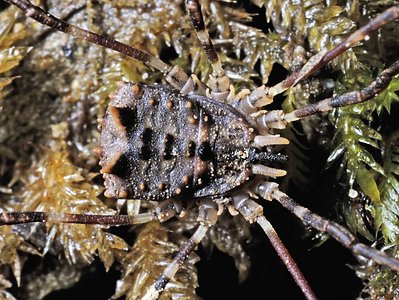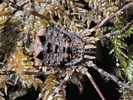Ceratolasmatidae
Axel Schönhofer


This tree diagram shows the relationships between several groups of organisms.
The root of the current tree connects the organisms featured in this tree to their containing group and the rest of the Tree of Life. The basal branching point in the tree represents the ancestor of the other groups in the tree. This ancestor diversified over time into several descendent subgroups, which are represented as internal nodes and terminal taxa to the right.

You can click on the root to travel down the Tree of Life all the way to the root of all Life, and you can click on the names of descendent subgroups to travel up the Tree of Life all the way to individual species.
For more information on ToL tree formatting, please see Interpreting the Tree or Classification. To learn more about phylogenetic trees, please visit our Phylogenetic Biology pages.
close boxIntroduction
The Ceratolasmatidae appear currently ill-defined (discussed below). Here, a narrow family concept is considered, including Acuclavella and Ceratolasma only, as these two genera are most likely closely related and share many morphological features. Similarities comprise the horned process on the eye mound, lack of bottle-brush hairs, a relatively simple penis and a characteristic composition of sternal elements (Shear 1986, Martens 1969). The two genera are restricted to the northwestern United States of America, where they inhabit permanently humid to wet habitats, often in combination with running water. The distribution of the genera does not overlap; neither seems to have specific microhabitat preferences (Shear 1986).
Taxonomy and Discussion of Phylogenetic Relationships
Ceratolasmatidae as defined and described by Shear (1986) has been altered considerably and now comprises the closely related genera Acuclavella and Ceratolasma. Still included is Crosbycus, whose position has been repeatedly questioned within the superfamily (e.g. Gruber 2007 and overview within, Giribet et al. 2010). It had been considered close to Hesperonemastoma by Shear (1986) but was not considered when Hesperonemastoma was transferred to Sabaconidae (Giribet et al. 2010). Good family definitions of Sabaconidae and Ceratolasmatidae are now lacking and will have to await a more comprehensive revision of the Ischyropsalidoidea. Ceratolasmatidae, reduced to Acuclavella and Ceratolasma, represents a well-supported morphological sister to Ischyropsalis (Martens 1969, Gruber2007).
References
Giribet, G., L. Vogt, A. Pérez González, P. Sharma and A. B. Kury 2010. A multilocus approach to harvestman (Arachnida: Opiliones) phylogeny with emphasis on biogeography and the systematics of Laniatores. Cladistics 26:408-437.
Gruber, J. 2007. Dyspnoi - Historical systematic synopsis. In: Pinto-da-Rocha, R., Machado, G., & Giribet, G. (eds.), Harvestmen: the biology of Opiliones. Harvard University Press, Cambridge: 131-135.
Martens, J. 1969. Die Abgrenzung von Biospezies auf biologisch-ethologischer und morphologischer Grundlage am Beispiel der Gattung Ischyropsalis C. L. Koch 1839 (Opiliones, Ischyropsalididae). Zoologische Jahrbücher Systematik 96 (2): 133-264.
Shear, W. A. 1986. A cladistic analysis of the opilionid superfamily Ischyropsalidoidea, with descriptions of the new family Ceratolasmatidae, the new genus Acuclavella, and four new species. American Museum Novitates 2844:1-29.
Title Illustrations

| Scientific Name | Ceratolasma tricantha |
|---|---|
| Specimen Condition | Live Specimen |
| Identified By | Axel Sch?nhofer |
| Sex | f |
| Life Cycle Stage | adult |
| Copyright |
© 2011 Axel Schönhofer

|
| Scientific Name | Acuclavella merickeli |
|---|---|
| Specimen Condition | Live Specimen |
| Identified By | Axel Sch?nhofer |
| Sex | f |
| Life Cycle Stage | adult |
| Copyright |
© 2011 Axel Schönhofer

|
About This Page
Many thanks to Angela DiDomenico for the final English check.
Axel Schönhofer

San Diego States University, San Diego, California, USA
Correspondence regarding this page should be directed to Axel Schönhofer at
Axel.Schoenhofer@uni-mainz.de
Page copyright © 2012 Axel Schönhofer
 Page: Tree of Life
Ceratolasmatidae .
Authored by
Axel Schönhofer .
The TEXT of this page is licensed under the
Creative Commons Attribution-NonCommercial License - Version 3.0. Note that images and other media
featured on this page are each governed by their own license, and they may or may not be available
for reuse. Click on an image or a media link to access the media data window, which provides the
relevant licensing information. For the general terms and conditions of ToL material reuse and
redistribution, please see the Tree of Life Copyright
Policies.
Page: Tree of Life
Ceratolasmatidae .
Authored by
Axel Schönhofer .
The TEXT of this page is licensed under the
Creative Commons Attribution-NonCommercial License - Version 3.0. Note that images and other media
featured on this page are each governed by their own license, and they may or may not be available
for reuse. Click on an image or a media link to access the media data window, which provides the
relevant licensing information. For the general terms and conditions of ToL material reuse and
redistribution, please see the Tree of Life Copyright
Policies.
- First online 08 July 2012
- Content changed 08 July 2012
Citing this page:
Schönhofer , Axel. 2012. Ceratolasmatidae . Version 08 July 2012 (under construction). http://tolweb.org/Ceratolasmatidae/60682/2012.07.08 in The Tree of Life Web Project, http://tolweb.org/





6.300a.jpg)

6.100a.jpg)

 Go to quick links
Go to quick search
Go to navigation for this section of the ToL site
Go to detailed links for the ToL site
Go to quick links
Go to quick search
Go to navigation for this section of the ToL site
Go to detailed links for the ToL site